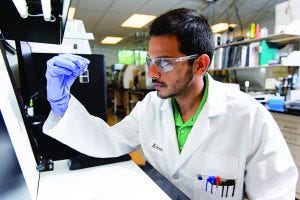Introduction: Emerging Therapies Come of AgeIntroduction: Emerging Therapies Come of Age
September 19, 2017

Rearchers are working on next-generation therapies to achieve targets not possible with traditional biologics. (WWW.IMMUNOGEN.COM)
According to a 2017 industry report, 74% of biopharmaceuticals currently in development (phase 1–3) are possible first-in-class medicines (those that use a unique mechanism of action), thus representing a potential new pharmacological class of treatment (1). They include regenerative medicines, conjugated monoclonal antibodies (MAbs), and DNA and RNA therapeutics. Some emerging therapies — such as antibody–drug conjugates (ADCs) and biobetters — have been more at the forefront of discussions than others, but all are poised to bring exciting changes to patient care. Authors and experts in this report discuss how meeting and optimizing specific process needs for those products will be imperative to keep pace with innovation.
Manufacturing processes for traditional biologics such as traditional (full-length) antibodies and vaccines are well established in most cases, but emerging therapies present unique processes demands. Major issues include the need for more efficient and scalable means of processing. Deciding on purification strategies, ensuring capacity to support commercial supply, addressing increased regulatory scrutiny, and developing analytical methods development for characterization of adenoassociated virus vectors (AAVs) for gene therapies are all primary topics of consideration. The report herein by Tony Hitchcock et al. covers development approaches to AAVs that are already in clinical trials.
ADCs represent a prominent research area, especially in use with cancer-treatment drugs and immunotherapies. But the complex molecular structures can present process and supply chain difficulties that limit the number of partner companies and contract manufacturing organizations (CMOs) that an innovator can work with. As Thomas Ryll observes in this report, ADC processing requires a “toolbox of solutions” that include different linkers, payloads, and conjugation technologies to address development issues such as payload potency and specific toxicity.
Recombinant Fc fusion proteins are produced in bacterial or mammalian host cells with recombinant DNA technology. Fusion can extend the half lives of biologics, improve their efficacy, and create desirable pharmacokinetic profiles for biobetters. Process difficulties, however, include protein degradation and instability. In his article, Stefan Schmidt discusses how controlling glycolysation during production can help manufacturers resolve such challenges.
A diverse range of antibody fragments offer many therapeutic advantages over full-length antibodies. Researchers construct bispecific antibodies to improve treatment effectiveness, reach specific target sites, and achieve dual-site targeting. Bispecific constructs come with process challenges such as the need to develop unique purification solutions. In my discussion with Jonathan Royce, he talks about both the opportunities and complications associated with processing such emerging therapies.
Reference
1 The Biopharmaceutical Pipeline: Innovative Therapies in Clinical Development. Pharmaceutical Research and Manufacturers of Amercia: Washington, DC, 17 July 2017; www.phrma.org/report/the-biopharmaceutical-pipeline.
Maribel Rios is managing editor of BioProcess International; [email protected].
You May Also Like






